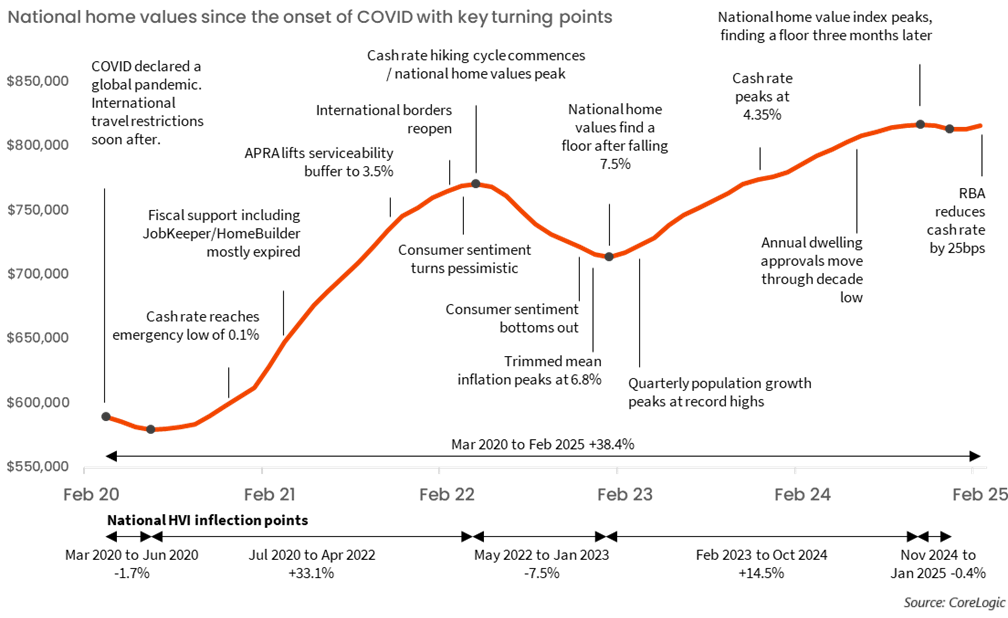Regional markets lead as affordability, migration, and rates drive housing trends

Since the World Health Organisation declared COVID-19 a global pandemic in March 2020, national dwelling values have risen by 38.4%, adding approximately $227,000 to the median home price, according to CoreLogic.
This compares to a 20.6% increase in the five years prior to the pandemic and a 14.7% rise in the five years before that. However, this growth has been uneven, shaped by shifting migration trends, interest rate movements, and affordability constraints.
Tim Lawless (pictured above), research director at CoreLogic Australia, noted that the early months of the pandemic saw a decline in home values, but this quickly shifted. “The national home value index dropped 1.7% in the early months of the pandemic but found a floor by June 2020,” he said.

The downturn was attributed to lockdown measures, border closures, and declining consumer confidence. From July 2020 to April 2022, prices surged 33.1%, despite a lack of overseas migration. A drop in household size, record-low interest rates, and government stimulus boosted demand.
The market then experienced a downturn as interest rates began rising, with values falling 7.5% over nine months. However, from February 2023 to October 2024, prices rebounded 14.5%, even amid high interest rates and affordability challenges.
“The most recent data shows housing values levelling off, with the national home value index edging lower by a cumulative 0.4% between November 2024 and January 2025 before rising 0.3% in February,” Lawless said.
Regional markets outperformed capital cities, with values rising 56.3% since March 2020, compared to a 33.6% increase in metropolitan areas. Early in the pandemic, lifestyle regions such as Byron Bay, Ballina, and Gympie saw the highest growth as remote work surged. More recently, regional Queensland and Western Australia have led price gains, reflecting affordability pressures in traditional lifestyle hubs.
Among capital cities, Perth saw the strongest growth, with values up 75.9%, followed by Adelaide at 73.1% and Brisbane at 68.7%. In contrast, Melbourne recorded the weakest increase at 8.4%, impacted by prolonged lockdowns, weak interstate migration, and subdued investor demand.
While mid-sized capitals led the pandemic-era housing boom, momentum is slowing. CoreLogic’s February 2025 data showed Melbourne and Hobart posting the strongest monthly gains at 0.4%, with both cities still below their peak values.
House prices have climbed 44.5% since March 2020, more than double the 20.1% increase in unit values. This gap was particularly pronounced during the early boom, as buyers prioritised space. However, affordability constraints and a shortage of new apartments have since narrowed the performance gap, with units recording an 11% gain from February 2023 to October 2024, compared to a 15.5% rise in house values.
“The percentage difference between the national median house and unit value reached a record high of 32% in June 2022, and based on the most recent data to February 2025, the difference remains elevated at 31.5%,” Lawless said.
Rental pressures intensify
Meanwhile, rental markets have tightened significantly, with CoreLogic’s national rental index rising 37.6% since March 2020 – nearly six times the growth seen in the previous five years. The median rent is now $177 per week higher than pre-pandemic levels.
Demand for rentals surged due to a drop in average household size and the return of international migration. House rents rose 38.7%, while unit rents increased 35.1%, though the latter fell initially when borders closed and students left the market.
Regionally, Western Australia and Queensland saw the highest rental growth, with Perth leading all capitals at 63.9%. Meanwhile, Hobart and the ACT experienced slower rental appreciation due to softening population growth and increased supply.
“Rental trends have been losing pace as affordability challenges become more substantial for renters, the average household size gradually rises and overseas migration normalises,” Lawless said.
Want to be regularly updated with mortgage news and features? Get exclusive interviews, breaking news, and industry events in your inbox – subscribe to our FREE daily newsletter. You can also follow us on Facebook, X (formerly Twitter), and LinkedIn.



